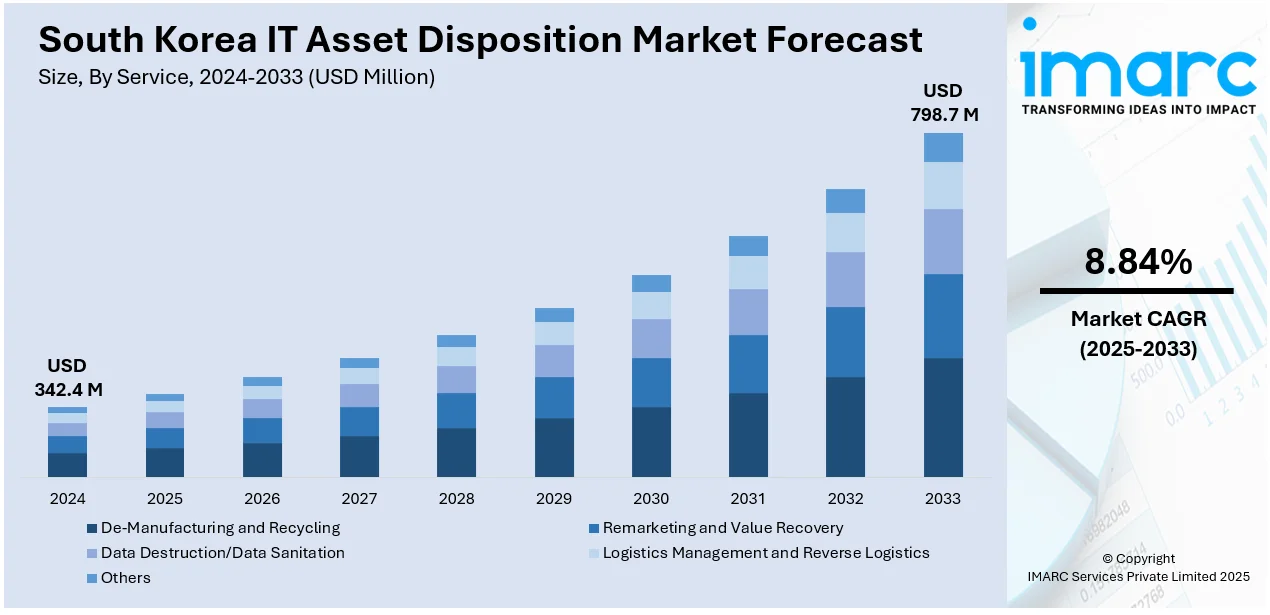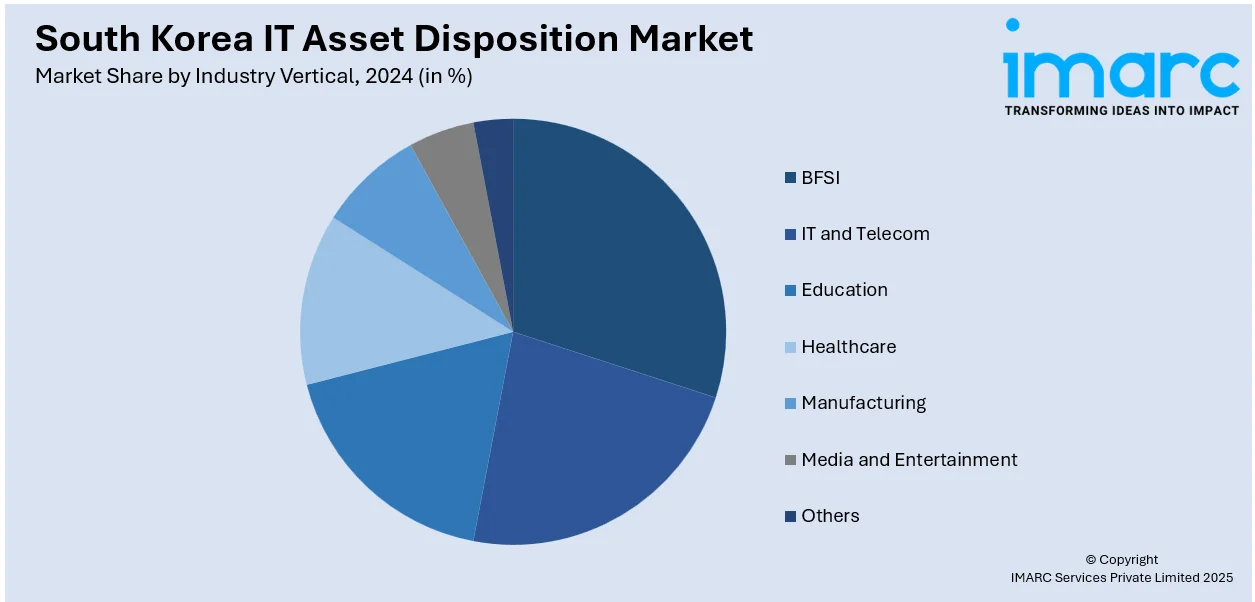
South Korea IT Asset Disposition Market Size, Share, Trends and Forecast by Service, Asset Type, Enterprise Size, Industry Vertical, and Region, 2025-2033
South Korea IT Asset Disposition Market Overview:
The South Korea IT asset disposition market size reached USD 342.4 Million in 2024. Looking forward, IMARC Group expects the market to reach USD 798.7 Million by 2033, exhibiting a growth rate (CAGR) of 8.84% during 2025-2033. Strong demand for secure disposal, stricter e-waste rules, growing corporate refresh cycles, data security concerns, rising awareness of environmental responsibility, vendor-managed recycling services, government sustainability policies, increased IT spending, and export restrictions are some of the factors contributing to South Korea IT asset disposition market share.
|
Report Attribute
|
Key Statistics
|
|---|---|
|
Base Year
|
2024
|
|
Forecast Years
|
2025-2033
|
|
Historical Years
|
2019-2024
|
| Market Size in 2024 | USD 342.4 Million |
| Market Forecast in 2033 | USD 798.7 Million |
| Market Growth Rate 2025-2033 | 8.84% |
South Korea IT Asset Disposition Market Trends:
Accelerating E-Waste Responsibility
In South Korea, the market for responsible IT equipment disposal is experiencing significant expansion. This surge is primarily fueled by a growing volume of electronic waste, coupled with heightened awareness of data security imperatives and a stronger emphasis on environmental responsibility. Local providers are expanding their operational reach and capabilities, including internationally, to address the increasing demand for secure data destruction and compliant e-waste recycling. This points to a broader industry shift towards comprehensive lifecycle management for technological assets, driven by both regulatory pressures and corporate sustainability goals. The focus is increasingly on secure, value-recovering, and environmentally sound practices for end-of-life IT hardware. These factors are intensifying the South Korea IT asset disposition market growth. For example, in March 2024, SK Ecoplant, a South Korean firm, expanded its IT Asset Disposition (ITAD) footprint globally, including through its subsidiary SK TES. While the recent news highlights its new data center server recycling plant in the US, SK TES already operates an ITAD and recycling facility in Seoul, South Korea, offering services like data destruction and e-waste recycling. The broader South Korean ITAD market is driven by increasing e-waste, data security concerns, and sustainability initiatives.

To get more information on this market, Request Sample
Circular Economy for Electronics Gaining Traction
A significant transformation is underway in how South Korea manages its technological resources, moving beyond mere disposal to embrace a more circular approach. This shift is driven by increasing regulatory mandates for electronic waste and heightened corporate awareness of environmental, social, and governance (ESG) responsibilities. Companies are increasingly seeking solutions that not only ensure secure data erasure but also prioritize the refurbishment and reuse of IT equipment, extending its lifecycle and minimizing its environmental footprint. The emphasis is on recovering value from retired assets through remarketing or component recovery, with proper recycling of unrecoverable materials. This marks a departure from linear "take-make-dispose" models, fostering a more sustainable and resource-efficient ecosystem for enterprise IT assets across the nation and beyond.
South Korea IT Asset Disposition Market Segmentation:
IMARC Group provides an analysis of the key trends in each segment of the market, along with forecasts at the country and regional levels for 2025-2033. Our report has categorized the market based on service, asset type, enterprise size, and industry vertical.
Service Insights:
- De-Manufacturing and Recycling
- Remarketing and Value Recovery
- Data Destruction/Data Sanitation
- Logistics Management and Reverse Logistics
- Others
The report has provided a detailed breakup and analysis of the market based on the service. This includes de-manufacturing and recycling, remarketing and value recovery, data destruction/data sanitation, logistics management and reverse logistics, and others.
Asset Type Insights:
- Computers and Laptops
- Servers
- Mobile Devices
- Storage Devices
- Others
A detailed breakup and analysis of the market based on the asset type have also been provided in the report. This includes computers and laptops, servers, mobile devices, storage devices, and others.
Enterprise Size Insights:
- Small and Medium-sized Enterprises
- Large Enterprises
A detailed breakup and analysis of the market based on the enterprise size have also been provided in the report. This includes small and medium-sized enterprises and large enterprises.
Industry Vertical Insights:

- BFSI
- IT and Telecom
- Education
- Healthcare
- Manufacturing
- Media and Entertainment
- Others
The report has provided a detailed breakup and analysis of the market based on the industry vertical. This includes BFSI, IT and telecom, education, healthcare, manufacturing, media and entertainment, and others.
Regional Insights:
- Seoul Capital Area
- Yeongnam (Southeastern Region)
- Honam (Southwestern Region)
- Hoseo (Central Region)
- Others
The report has also provided a comprehensive analysis of all the major regional markets, which include Seoul Capital Area, Yeongnam (Southeastern Region), Honam (Southwestern Region), Hoseo (Central Region), and others.
Competitive Landscape:
The market research report has also provided a comprehensive analysis of the competitive landscape. Competitive analysis such as market structure, key player positioning, top winning strategies, competitive dashboard, and company evaluation quadrant has been covered in the report. Also, detailed profiles of all major companies have been provided.
South Korea IT Asset Disposition Market Report Coverage:
| Report Features | Details |
|---|---|
| Base Year of the Analysis | 2024 |
| Historical Period | 2019-2024 |
| Forecast Period | 2025-2033 |
| Units | Million USD |
| Scope of the Report |
Exploration of Historical Trends and Market Outlook, Industry Catalysts and Challenges, Segment-Wise Historical and Future Market Assessment:
|
| Services Covered | De-Manufacturing and Recycling, Remarketing and Value Recovery, Data Destruction/Data Sanitation, Logistics Management and Reverse Logistics, Others |
| Asset Types Covered | Computers and Laptops, Servers, Mobile Devices, Storage Devices, Others |
| Enterprise Sizes Covered | Small and Medium-sized Enterprises, Large Enterprises |
| Industry Verticals Covered | BFSI, IT and Telecom, Education, Healthcare, Manufacturing, Media and Entertainment, Others |
| Regions Covered | Seoul Capital Area, Yeongnam (Southeastern Region), Honam (Southwestern Region), Hoseo (Central Region), Others |
| Customization Scope | 10% Free Customization |
| Post-Sale Analyst Support | 10-12 Weeks |
| Delivery Format | PDF and Excel through Email (We can also provide the editable version of the report in PPT/Word format on special request) |
Key Questions Answered in This Report:
- How has the South Korea IT asset disposition market performed so far and how will it perform in the coming years?
- What is the breakup of the South Korea IT asset disposition market on the basis of service?
- What is the breakup of the South Korea IT asset disposition market on the basis of asset type?
- What is the breakup of the South Korea IT asset disposition market on the basis of enterprise size?
- What is the breakup of the South Korea IT asset disposition market on the basis of industry vertical?
- What is the breakup of the South Korea IT asset disposition market on the basis of region?
- What are the various stages in the value chain of the South Korea IT asset disposition market?
- What are the key driving factors and challenges in the South Korea IT asset disposition market?
- What is the structure of the South Korea IT asset disposition market and who are the key players?
- What is the degree of competition in the South Korea IT asset disposition market?
Key Benefits for Stakeholders:
- IMARC’s industry report offers a comprehensive quantitative analysis of various market segments, historical and current market trends, market forecasts, and dynamics of the South Korea IT asset disposition market from 2019-2033.
- The research report provides the latest information on the market drivers, challenges, and opportunities in the South Korea IT asset disposition market.
- Porter's five forces analysis assist stakeholders in assessing the impact of new entrants, competitive rivalry, supplier power, buyer power, and the threat of substitution. It helps stakeholders to analyze the level of competition within the South Korea IT asset disposition industry and its attractiveness.
- Competitive landscape allows stakeholders to understand their competitive environment and provides an insight into the current positions of key players in the market.
Need more help?
- Speak to our experienced analysts for insights on the current market scenarios.
- Include additional segments and countries to customize the report as per your requirement.
- Gain an unparalleled competitive advantage in your domain by understanding how to utilize the report and positively impacting your operations and revenue.
- For further assistance, please connect with our analysts.
 Request Customization
Request Customization
 Speak to an Analyst
Speak to an Analyst
 Request Brochure
Request Brochure
 Inquire Before Buying
Inquire Before Buying




.webp)




.webp)












